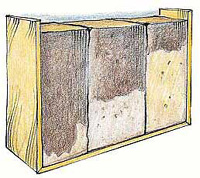|
|
Watering your plants |

|
|
Watering your plants |

The amount of water that is needed depends a lot on the kind of soil. If you pour the same amount of water into sand, loam (good garden soil) and clay, the water soaks down a lot further into the sand, and least of all into the clay. But if you let it drain out the bottom again, the sand will dry out the fastest, and the clay will dry out the slowest of all the three samples. What does that mean when it comes to watering plants growing in those kinds of ground?

Plants, like animals, need water to live. A seed must absorb water before it can germinate. Roots can take up nutrients only when water is present in the soil, because water carries the nutrients throughout the plant. And water is essential to photosynthesis.
Your soil's ability to absorb and retain water is closely related to what it is made of. Clay soils absorb water slowly and drain slowly as well, retaining water longer than other soils. Sandy soils, in contrast, absorb water quickly and drain just as quickly. Loam soils absorb water fairly rapidly and drain well, but not too fast.
Once their roots are established, different sorts of plants have widely differing water needs. Plants native to arid climates, like cacti, have evolved features that allow them to survive with little water. They may have deep root systems, for example, or leaves that are small, hairy, or waxy. Most familiar garden plants, however, are adapted to moist soil. They usually have broad, thin leaves. Keep in mind that all young plants need more frequent watering than mature plants until their root systems become well established. And many annuals and vegetables require regular moisture throughout the growing season if they are to bloom well or produce a good crop.

Giving plants too much water, especially in clay soils, can cause as many problems as supplying too little. Roots absorb oxygen from the air found in pore spaces between soil particles. When it rains, water takes the place of the air in these spaces; then, as the water is used, the pore spaces fill with air again. But if water is applied too often, the pore spaces never have a chance to drain. They remain filled with water, and air is not available to the roots. The lack of oxygen then makes the roots rot. Overwatering also compacts the soil and literally washes some nutrients beyond the reach of roots.
Weather affects water needs as well. When it's hot, dry, and windy, plants use water very rapidly, and young or shallow-rooted ones sometimes cannot absorb water fast enough to keep foliage from wilting. Such plants need frequent watering to keep moisture around their roots at all times. During cool, damp weather, on the other hand, plants require much less water. Water needs are lower during winter as well, when the days are short and the sun is low on the horizon.